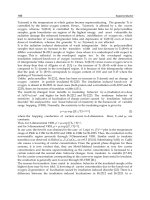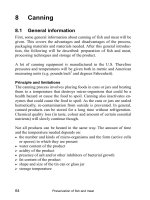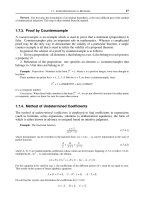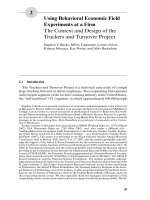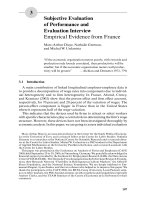The Analysis of Firms and Employees Part 8 pps
Bạn đang xem bản rút gọn của tài liệu. Xem và tải ngay bản đầy đủ của tài liệu tại đây (161.63 KB, 14 trang )
8.1 Introduction
How do firms adjust their personnel policies and internal structure to
changes in their economic and institutional environment? Chandler (1977)
has investigated how firms in the last century reacted to challenges posed
by new technologies and by market demands by developing professional
management, the line/staff, and later the multidivisional organization. Do-
eringer and Piore (1971) have documented how and why firms created in-
ternal labor markets to protect their workers from market shocks and
to provide them with incentives to invest in firm-specific human capital.
Following Carter and Carter (1985), Lazear (1992), and Baker, Gibbs, and
Holmström (1994), a literature has emerged that investigates the personnel
files of single firms over a long period of time to learn more about their
internal labor markets.
1
One main finding is that a firm’s organizational
structure and career paths remain remarkably stable, even in turbulent
times.
253
8
Insider Privatization and Careers
A Study of a Russian Firm
in Transition
Guido Friebel and Elena Panova
Guido Friebel is a researcher at the Institute of Industrial Economics (IDEI) and a lecturer
at EHESS, the French School for Advanced Studies in Social Sciences, both at the University
of Toulouse, and is affiliated with the Centre for Economic Policy Research (CEPR). Elena
Panova is an assistant professor of economics at the University of Quebec at Montreal.
We would like to thank the editor, Julia Lane, and two referees. We are also grateful to Erik
Berglöf, Anders Björklund, Peter Gottschalk, Joep Konings, Margaret Meyer, Marc-
Andreas Muendler, Åsa Rosén, Kathy Terrell, and seminar participants at the CAFE confer-
ence in Nuremberg, Boston College, LICOS Leuven, London Business School, SITE (Stock-
holm School of Economics), SOFI (Stockholm University), University of Michigan, and the
University of Toulouse. We are grateful for the support of SITE. All errors are ours.
1. A non-exhaustive list includes Ariga, Ohkusa, and Brunello (1999), Dohmen (2004) and
Dohmen, Kriechel, and Pfann (2004), Ichino and Maggi (1999), Seltzer and Merret (2000),
and Treble et al. (2001).
In this chapter, we investigate how Russian transition from a centrally
planned to a market economy has affected human resource policies of a
heavy-industry firm. We use a personnel data set that covers a total of 1,538
white-collar workers over up to seventeen years: from 1984 to 2000. We
find that from 1984 to 1991 (hereafter, in Soviet times), the firm featured
stable patterns of upward mobility that look quite similar to the career
paths in Western firms. From the year 1992, when Gaidar’s reforms began,
to 2000 (hereafter, during the transition), these career paths seem blocked.
We identify the reason for this observation: in all tiers of the firm’s hier-
archy except for the lowest one, both (a) more managers are hired from the
outside market, and (b) fewer managers leave the firm. As a result, the firm
becomes toploaded, and promotions are blocked.
What is more difficult is to identify the rationale behind such a firm strat-
egy. We hypothesize that this strategy may be constrained optimal in the
Russian environment. Here, outsiders receive notoriously weak protection
for their property rights (see, for instance, Woodruff 2004). The privatiza-
tion law provided insiders with favors through the so-called option 2 of
the Russian voucher privatization. Hence, in 1993, incumbent managers ef-
fectively became the owners. The inside owners had the opportunity to
hire managers with higher human capital than themselves,
2
most probably
because skilled employees were leaving less successful enterprises.
3
The
manager-owners decided both (a) to take advantage of this opportunity,
and (b) to stay in the firm (in order to enforce their property rights).
4
Con-
sequently, career paths are blocked and the firm forgoes the benefit of using
careers as a device for providing effort incentives and screening workers.
5
The remainder of the chapter is organized as follows. Section 8.2 de-
scribes the ownership structure, output performance, and employment
policies from the firm-level perspective. Section 8.3 uses the personnel data
to compare human resource policies in Soviet times and during the transi-
tion. The last Section summarizes and discusses the main insights.
8.2 The Firm and Its Environment
The firm we investigate is one of the largest enterprises in the machinery
industry in Russia. It was established in 1949. Prior to transition, it was one
254 Guido Friebel and Elena Panova
2. Managers hired after 1992 have been both more experienced and better educated than
incumbents working on the same level.
3. Between 1996 and 1999, industrial employment in the region where the firm that we study
is located has decreased by 9 percent. In the same period, the employment in the firm has de-
creased by only 6 percent.
4. Potentially, the newly hired managers could take over control of the firm. However, once
again, the weak enforcement of outsider ownership rights constitutes an obstacle, as banks
are not willing to provide credit for acquisition of the firm’s shares.
5. Career prospects are among the most important instruments for encouraging employees
to invest in firm-specific human capital (see Gibbons and Waldman 1999). Also, promotions
signal the quality of employees, helping thereby to better allocate them among tasks (see
Waldman 1984; Sattinger 1993).
of the leading companies in the industry and was awarded a number of dis-
tinctions. This section uses firm-level data
6
to describe how the firm was
evolving in a changing institutional environment.
8.2.1 Ownership Structure
In March 1993, the firm was privatized through the so-called option 2 of
the Russian voucher privatization, which provided privileges to insider
workers and managers in acquiring shares. Since then, it has been a joint
stock company. The annual report for 1997 indicates about 92 percent in-
dividual ownership. A total of 53.4 percent of the firm is owned by insid-
ers. Neither municipality nor the regional government own shares, and
there is no foreign capital. We have no information about the distribution
of shareholdings. However, according to our interviews with managers in
the firm, nonmanagerial employees delegate their votes to the manager of
their department.
8.2.2 Output Performance
We do not have access to good measures of profitability. Looking at out-
put gives, however, a good idea of the restructuring process the firm went
through. In 1987 there was a first output decline when the firm had to cope
with Gorbachev’s perestroyka. Decentralization of decisionmaking power
damaged some of the traditional supply channels and affected demand.
There is thus a steep drop in output from the beginning of Gaidar’s reforms
in 1992 onward, which is typical for these years—in particular, for heavy
industry. From 1997, there was a positive tendency, and in 1999, the enter-
prise won an important contract to supply equipment to India.
At different points in time, the firm experimented with new product
lines—for instance, tailor-made instruments. From late 1980s until the late
90s it has also been producing consumer goods (plastic chairs and tables).
However, figure 8.1 shows that there is a high correlation between the firm’s
output and its specialization in the core business—the production of heavy
machinery items. The fact that the firm operates in a specialized market
with high fixed costs and high entry barriers may explain why the firm sur-
vived transition relatively well.
8.2.3 Employment Policies, Aggregate (Firm-Level) Perspective
Between 1988 and 1997, industrial employment—that is, the number of
workers employed in the core operations of the firm,
7
has steadily declined.
Insider Privatization and Careers 255
6. Unfortunately, we have no individual-level information about blue-collar workers, except
for those who at some stage in their career moved into white-collar or managerial positions.
However, we have firm-level information about the employment and wages by both blue-
collar and white-collar employees.
7. Similar to many other large industrial firms in Russia, the firm that we study had a large
number of employees in nonindustrial activities such as restaurants, hospitals, kindergartens,
and housing. These individuals are out of our consideration.
Indeed, it fell from 4,813 in 1998 to 3,206 in 1998. Unfortunately, we can-
not distinguish between an involuntary dismissal and a voluntary quit: it is
a tradition in Russia to label any separation as a “quit” so as to avoid sub-
sequent stigmatization of a worker.
During transition, employment becomes more sensitive to output
changes. However, it reacts with a lag. The most important wave of sepa-
rations occurred in 1997, the first year of transition in which the firm’s real
output has grown. Interestingly, that wave of separations followed the top
manager’s dismissal, initiated by the employees: an evidence of an active
stance by new owners in the firm.
Furthermore, during transition, an increasing share of the total wage
bill (including wage arrears and in-kind payments) was allocated to white-
collar workers, and the ratio between white-collar and blue-collar workers
increased. Notice that this implies that more and more blue collars leave
the firm (recall that industrial employment has steadily declined).
8
Hence,
the firm’s defensive (cost-cutting) restructuring has mainly affected its
blue-collar workers.
9
256 Guido Friebel and Elena Panova
8. By the end of nineties, however, blue collars are more and more demanded by enterprises
located in the same region as the firm that we study: the ratio of white-collar to blue-collar va-
cancies in the region has decreased from 0.59 in 1996 to 0.2 in 2000.
9. Following Grosfeld and Roland (1997), we distinguish between defensive and strategic
restructuring. For a model on defensive and strategic restructuring of insider-privatized firms,
see Debande and Friebel (2004).
Fig. 8.1 Output and specialization
8.3 Personnel Policies of the Firm
8.3.1 Personnel Data
In order to better understand how transition has affected the firm’s hir-
ing and promotion policies,
10
we investigate seventeen years (1984–2000)
of personnel files of 1,538 white-collar workers of the firm.
We use the raw data from the human resource department. An em-
ployee’s personnel file contains the date of accession, the date of separation,
dates of movements across job titles, and an occupational code for each po-
sition defined by Goskomstat, the statistical office of Russia. We also know
whether, in a given moment in time, an individual works in production and
engineering or in administration (sales, planning, accounting).
Moreover, we know the following personal characteristics: age, work ex-
perience, education (years of schooling), gender, party and trade union
membership, ethnicity, marital status, number of children, place of birth,
place of university education, and field of study. We also know some of the
job history of an individual: military service, date of leaving previous job,
last employer. Unfortunately, we do not have access to information about
individual wages.
8.3.2 Hierarchy and Career Paths
As in other related work (for instance, Baker, Gibbs, and Holmström
1994), human resources, as measured by “persondays per title,”
11
are con-
centrated on few job titles.
12
In our case, twelve job titles represent about
90 percent of core white-collar staff. We thus focus on these job titles.
They are located on five levels of the firm’s hierarchy (see table 8.1):
13
On
Insider Privatization and Careers 257
10. Although we find more downward mobility than in other related work (there were 120
demotions in Soviet times, and 97 during the transition), we have not studied its determinants.
The reason is that results could be difficult to interpret. Indeed, according to our interviews
with human resource departments, demotions are typically used as an employment insur-
ance, in cases when (a) an employee reaches a retirement age, or (b) he or she becomes unable
to fulfill his or her duties for health reasons, or (c) he or she receives a primary job outside the
firm—for instance, in an informal sector.
11. For any given individual, we know (a) the date of accession into the firm, and the ac-
cession job title (b), and the duration of stay on a given job title. For each job title, we can then
add up the persondays over individuals. These persondays per title can be expressed as a ra-
tio of the total human resources in the firm.
12. Of course, each job title contains a variety of specifications, as described by Goskom-
stat’s 5-digit code. However, we have pooled down most of that variety, making a distinction
between employment in production and in administration.
13. We have carried out a similar exercise as the one by Baker, Gibbs, and Holmström
(1994). They looked at the flows of human resources between different job titles. They estab-
lished the lowest level of the hierarchy, mostly filled by workers hired on the outside market.
Afterward, they determined level 2 by looking at “where do employees mostly move from level
1.” They proceeded in the same way up to the top of the hierarchy (the general manager). Car-
rying out this procedure, we generated a hierarchy that was identical to the one we later re-
ceived from the human resource department of the firm.
level 1: technician, planning technician, and accountant; on level 2: econ-
omist, planning engineer, engineer working in production unit, and fore-
man (a managerial position in production);
14
on level 3: head of bureau,
responsible for a nonproduction unit, and supervisor of a production unit;
on level 4: head of production and head of nonproduction departments; on
level 5: top manager.
Comparing the two columns of table 8.1, we see that during transition,
the firm has shifted employees from production-oriented job titles (techni-
cian, engineer) to job titles that are related to business administration and
development (accountant, economist, planning technician, and planning
engineer). Moreover, it has reallocated human resources toward four man-
agerial jobs (supervisor of production unit, head of production depart-
ment, head of nonproduction department, and top manager).
To find patterns of internal mobility, we compute a transition matrix
that captures accessions to and separations from the firm, and movements
across job titles for the whole time interval. We find that in the Soviet era,
the firm maintained career paths, some of them leading to the very top of
the company (these paths are depicted by arrows;
15
see figure 8.2). The
numbers represent the probability of transition of a person from one job
258 Guido Friebel and Elena Panova
14. Becoming a foreman is a typical promotion for a blue-collar worker.
15. We here plot links between job titles that have a transition probability of at least 5 per-
cent.
Table 8.1 Allocation of human resources across jobs
Percentage of person Percentage of person
Job title days before 1992 days after 1992
Level 5
Top management 3 4
Level 4
Head of production department 3 5
Head of department 2 2
Level 3
Supervisor 1 2
Head of bureau 8 9
Level 2
Engineer 43 38
Foreman 15 17
Planning engineer 4 5
Economist 3 5
Level 1
Technician 5 2
Accountant 2 4
Planning technician 1 2
title to the job title the arrow points to. This picture is very similar to the
one that Baker, Gibbs, and Holmström (1994) find. (See also figure 8.3.)
In Soviet times, employment and upward mobility were distorted by po-
litical influence. Hence, career paths may have served both efficiency and
political goals. Nonetheless, there is some evidence that firms used promo-
tions as the main instrument to incentivise, and, in particular, to retain
their workers (see Kornai 1992). The main difference between Soviet and
western firms is not so much the use of promotions, but rather the fact that
in Soviet firms, promotions provided access to additional fringe benefits
rather than substantial wage increases.
Transition changes the firm’s promotion policies. Indeed, it becomes
more or less impossible to move upward beyond level 2 (see table 8.2). The
reason is that the previously existing career paths are blocked by increased
hiring activity from the outside labor market to the upper levels of the hier-
archy (see figure 8.2).
16
Managers recruited above the second level are
Insider Privatization and Careers 259
16. These policies may be optimal response from a constrained efficiency perspective. We
thank Marc-Andreas Muendler for his discussion of this point.
Fig. 8.2 Mobility during Soviet times
Fig. 8.3 Mobility in transition
Table 8.2 Schooling and work experience, incumbents versus new hires
Level
2345
Years of schooling
1984–1991 14.24 14.40 14.33 15.66
Hired from the outside 14.73 15.08 14.70 16.00
Incumbents 13.50 14.29 14.26 15.62
1992–2000 14.26 14.32 14.53 15.79
Hired from the outside 14.62 15.47 14.93 16.00
Incumbents 13.38 13.90 14.19 15.55
Work experience
1984–1991 11.58 19.51 18.54 20.96
Hired from the outside 8.31 21.17 15.10 22.67
Incumbents 16.56 19.24 19.18 20.76
1992–2000 14.00 21.77 18.77 21.67
Hired from the outside 12.48 22.26 20.63 23.46
Incumbents 17.67 21.59 17.21 19.55
better educated and more experienced as compared both to the incum-
bents, and to those managers who were recruited on the same level in So-
viet times (see table 8.2).
8.3.3 Hazard Rates of Promotions and Exits
In order to better understand how transition has affected labor mobility
inside the firm, we consider separately two time intervals: 1984–1992 and
1992–2000. For each of them, we carry out a duration analysis on two
events: (1) a promotion, that is, a move from a lower to a higher level of the
hierarchy, and (2) a separation from the firm.
17
(See table 8.3.)
We first consider promotions. The data are translated into the survival
time form. We observe an individual at the beginning of a time interval
(controlling for the exact date of the recruitment). To adjust time-varying
variables (such as age), we make at least one record in three years. We doc-
ument the time spans (the “survival time”) until a promotion.
18
After each
promotion, the survival time is reset to 0.
19
We use an accelerated failure-time model, in which the natural logarithm
of the survival time is assumed to be linearly dependent on covariates:
20
ln(t
j
) ϭ x
j
ϩε
where x
j
is a covariate vector,  is a vector of regression coefficients, and
ε is an error term with density f(·). As covariates, we pick three basic indi-
Insider Privatization and Careers 261
17. We use the terms of duration analysis from labor economics (Van den Berg 2001).
18. Because there is always a record at the exact date of a promotion, the time interval be-
tween two records can be shorter than three years.
19. Our data set contains repeated records of the same individuals. Hence, the assumption
of independent observations may not be adequate. Therefore, we use a robust estimate of vari-
ance, controlling for identity.
20. A statistical test based on the distribution of Schoenfeld residuals rejected the Cox
proportional-hazard model.
Table 8.3 Staffing from outside and from within (numbers in parentheses
are promotions)
Level
2345
Accession to a level 1 (895) 1 (155) 1 (118) 1 (53)
1984–1991 0.55 0.55 0.52 0.55
1992–2000 0.45 0.45 0.48 0.46
Hired from outside 0.74 0.20 0.31 0.30
1984–1991 0.37 0.08 0.08 0.06
1992–2000 0.37 0.12 0.23 0.25
Promoted 0.26 0.80 0.69 0.70
1984–1991 0.14 0.48 0.43 0.49
1992–2000 0.11 0.32 0.25 0.21
vidual characteristics: age and education (to measure human capital),
21
and
gender.
22
We assume that the density of the error term follows a generalized
Gamma model
23
:
f(t) ϭ
Ά
(κ
Ϫ2
)
κ
Ϫ2
exp
κ
Ϫ2
Ά
κ Ϫ exp
΄
κ
΅·
,
if κ 0;
exp
Ά
Ϫ
·
, if κ ϭ 0,
where κ and are ancillary parameters to be estimated from the data (see
Kalbfleish and Prentice 1980).
We find that in Soviet times, being younger, male, and having a better ed-
ucation was helpful for a promotion. In contrast, during transition, age
and education variables are no longer statistically significant (see table
8.4). More importantly, in Soviet times an employee could increase his or
her probability to receive a promotion by simply staying in the firm. Dur-
ing the transition, however, only the first few years of waiting for a promo-
tion increased the probability of this event: waiting longer would actually
decrease the probability of moving up the firm’s hierarchy (see figure 8.4).
24
We proceed in a similar way for separations. We again use a generalized
Gamma model with controlling variables: age, education, gender, and level
in the hierarchy. The most important result is that despite worsening career
perspectives during transition, workers are less likely to leave the firm (see
table 8.5), especially from the upper levels of the hierarchy.
25
[ln(t) Ϫ x]
2
ᎏᎏ
2
2
1
ᎏ
͙2
ෆ
ln(t) Ϫ x
ᎏᎏ
ln(t) Ϫ x
j

ᎏᎏ
|κ|
ᎏ
⌫(κ
Ϫ2
)
262 Guido Friebel and Elena Panova
21. Age is highly correlated with work experience.
22. We have added to the set of covariates the following individual characteristics: number
of children, dummy for being born in the region, dummy for employment in production divi-
sion of the firm at some point of the career, and party membership. It turned out that none
are statistically significant, even though we were adding them to the set of three basic covari-
ates one by one (indeed, party membership was significant at a 15 percent level in Soviet times,
and became insignificant during transition). At the same time, age, education, and gender re-
mained significant, with the same sign in all regressions. We have not tried to use labor union
membership as a regressor, because there is too little variation in the data: until the year 2000,
the firm remains highly (more than 80 percent) unionized.
23. We used the Akaike Information Criterion to select the generalized gamma form among
Exponential, Weibull, Lognormal, Log-logistic, and generalized Gamma distributions. More-
over, the Wald likelihood ratio test has rejected the hypothesis of a Weibull distribution
κ ϭ 1. Hence, we have not imposed any restrictions on the highly flexible baseline hazard
function of the generalized Gamma distribution.
24. Notice also, that the incidence of promotion during the transition is only 64, as com-
pared to 150 in Soviet times (the number of individuals in the two periods is more or less the
same).
25. There were only 316 separations during transition, as compared to 609 in Soviet times.
8.4 Concluding Discussion
We have investigated how transition, a particularly drastic process of in-
stitutional and structural change, has affected the personnel policies of a
Russian firm. A sizeable literature on enterprise restructuring in transition
measures the impact of privatization, the hardening of budget constraints,
increasing competition, and price liberalization on enterprise performance
Insider Privatization and Careers 263
Table 8.4 Promotion regressions
1984 to 1991
1992 to 2000
Robust Robust
σ| *coefficient standard error σ *coefficient standard error
Years of schooling 0.05** 0.01 –0.08 0.05
Dummy for sex (1 = male) 0.96** 0.012 0.92** 0.43
Age in years –0.03** 0.01 0.02 0.01
Constant –3.24** 0.029 –2.12* 1.19
ln
σ
0.67** 0.10 0.549 0.16
κ| –0.76** 0.18 –3.30 1.14
σ| –0.51 0.05 1.73 0.28
Number of observations 3510 3148
Number of promotions 158 64
Number of individuals 1088 991
Time at risk 5120.13 4959.95
Log likelihood –213.83 –195.44
Wald χ
2
173.49 19.86
Probability χ
2
0.000 0.000
Note: *Significantly different from zero at the 10 percent level.
**Significantly different from zero at the 5 percent level.
Fig. 8.4 Baseline promotion hazards, Soviet times versus transition
(see Djankov and Murrell 2002). Insider-privatized firms usually show little
signs of restructuring, while firms that are privatized to outsiders, in partic-
ular to foreigners, are more likely to improve their performance. In order to
learn more about the microchannels through which transition affects enter-
prise performance, we open the black box of a heavy industry firm.
The main changes after the reforms are as follows:
1. Employment becomes more responsive to output changes after pri-
vatization.
2. The wage bill is reallocated from blue to white collar.
3. Separations affect blue-collar workers whereas white collars, espe-
cially those working in the upper tiers of the hierarchy, are less likely to
leave the firm than before the reforms.
4. The use of white-collar human resources is shifted from production
to administrative and management activities.
5. More white-collar workers are hired from the outside labor market,
in particular for higher levels of its hierarchy.
6. The firm becomes toploaded, and career paths are blocked.
We cannot judge to what extent all of these changes have been introduced
with an aim to increase efficiency. The fact that the inside managers are
residual claimants makes us believe, though, that the firm acts in a profit-
maximizing way, taking the institutional framework as given. In general,
264 Guido Friebel and Elena Panova
Table 8.5 Separation regressions
1984 to 1991
1992 to 2000
Robust Robust
σ *coefficient standard error σ| *coefficient standard error
Years of schooling 0.06* 0.01 0.03 0.05
Dummy for sex (1 = male) 0.53* 0.012 0.97* 0.21
Age in years 0.01 0.01 –0.01 0.01
Level in the hierarchy 0.10* 0.05 –0.26** 0.11
Constant –1.49* 0.39 –1.8** 0.79
ln
σ
0.65* 0.01 0.59* 0.01
κ| 1.70* 0.14 –0.19 0.15
σ 1.91 0.07 1.81 0.08
Number of observations 3510 3148
Number of separations 609 316
Number of individuals 1088 991
Time at risk 5120.13 4959.95
Log likelihood –1600.03 –712.90
Wald χ
2
37.73 26.17
Probability χ
2
0.000 0.000
Note: *Significantly different from zero at the 10 percent level.
**Significantly different from zero at the 5 percent level.
firms are frequently limited in their capacity to maintain career paths and
other elements of internal labor markets when their environment changes
(Bertrand 2004). The specificity of our case is the notoriously weak pro-
tection of outsider property rights in Russia, which created strong incen-
tives for the manager-owners to stay inside the firm. At the same time, the
Russian labor market became thicker, making it possible to hire new work-
ers and managers with higher human capital. Manager-owners seem to
have made use of these recruitment opportunities, even at the expense of
interrupting career paths altogether.
We cannot claim any generality for Russian firms, as we only had access
to one data set. The case study opens, however, a new perspective on how
corporate governance institutions shape the structure and human resource
policies of firms, and we hope that it may provide food for thought for the-
oretical analyses.
References
Ariga, Kenn, Yasushi Ohkusa, and Giorgio Brunello. 1999. Fast track: Is it in the
genes? The promotion policy of a large Japanese firm. Journal of Economic Be-
havior and Organization 38:385–402.
Baker, George, Michael Gibbs, and Bengt Holmström. 1994. The internal eco-
nomics of the firm: Evidence from personnel data. Quarterly Journal of Econom-
ics 109:881–919.
Bertrand, Marianne. 2004. From the invisible handshake to the invisible hand?
How import competition changes the employment relationship. The Journal of
Labor Economics 22(4): 723–66.
Carter, Michael, and Susan Carter. 1985. Internal labor markets in retailing: The
early years. Industrial and Labor Relations Review 38:586–98.
Chandler, Alfred D. 1977. The visible hand: The managerial revolution in American
business. Cambridge, MA: Harvard University Press.
Debande, Olivier, and Guido Friebel. 2004. A positive theory of “give-away” pri-
vatization. International Journal of Industrial Organization 22(8):1309–25.
Djankov, Simeon, and Peter Murrell. 2002. Enterprise restructuring in transition:
A quantitative survey. Journal of Economic Literature 40:739–92.
Doeringer, Peter, and Michael Piore. 1971. Internal labor markets and manpower ad-
justment. Lexington, MA: D.C. Heath.
Dohmen, Thomas. 2004. Performance, seniority and wages: Formal salary systems
and individual earnings profiles. Labour Economics 11:741–63.
Dohmen, Thomas, Ben Kriechel, and Gerard A. Pfann. 2004. Monkey bars and
ladders: The importance of lateral and vertical job mobility in internal labor
market careers. Journal of Population Economics 17:193–228.
Gibbons, Robert, and Michael Waldman. 1999. Careers in organizations: Theory
and evidence, in Handbook of labor economics, ed. Orley C. Ashenfelter and
David Card, vol. 3B:2373–2437. Amsterdam: Elsevier Science.
Grosfeld, Irena, and Gerard Roland. 1997. Defensive and strategic restructuring in
Central and Eastern European Enterprises. Journal of Transforming Economies
and Societies 3:21–46.
Insider Privatization and Careers 265
Ichino, Andrea, and Giovanni Maggi. 1999. Work environment and individual
background: Explaining regional shirking differentials in a large Italian firm.
Quarterly Journal of Economics 115:1057–90.
Kalbfleish, J. D., and R. L. Prentice. 1980. The statistical analysis of failure time
data. New York: Wiley.
Kornai, Janos. 1992. The socialist system—The political economy of communism.
Princeton, NJ: Princeton University Press.
Lazear, Edward. 1992. The job as a concept. In Performance measurement, evalua-
tion, and incentives, ed. William J. Bruns, 183–215. Boston: Harvard Business
School Press.
———. 2000. Performance pay and productivity. American Economic Review
90:1346–61.
Sattinger, M. 1993. Assignment models of the distributional earnings. Journal of
Economic Literature 31:831–80.
Seltzer, Andre, and David Merrett. 2000. Personnel policies at the Union Bank of
Australia: Evidence from the 1888–1900 entry cohorts. Journal of Labor Eco-
nomics 18:573–613.
Treble, John, Tim Barmby, Sarah Bridges, and Edwin van Gameren. 2001. The in-
ternal economics of the firm: Further evidence from personnel data. Labour Eco-
nomics 8:531–52.
Van den Berg, Gerard. 2001. Duration models: Specification, identification, and
multiple durations. In J. J. Heckman and E. Leamer, eds., Handbook of econo-
metrics, Vol. 5. Amsterdam: North-Holland.
Waldman, M. 1984. Worker allocation, hierarchies and the wage distribution. Re-
view of Economic Studies 51:95–109.
Woodruff, Chris. 2004. Property rights in context: Privatization’s legacy for corpo-
rate legality in Poland and Russia. Studies in Comparative International Develop-
ment 38:82–108.
266 Guido Friebel and Elena Panova


